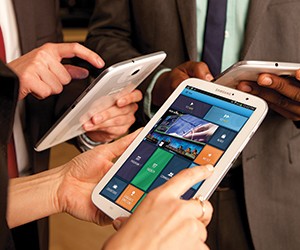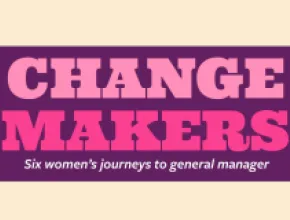Imagine a meeting with almost no paper. No program, no schedule, no handouts, no daily meeting newspaper. Paper is an option for anyone who wants it, with dozens of laser printers placed around the venue. And almost nobody uses them. More than 11,000 attendees and less than 500 pages printed over five days.
That was the scene at the Transcatheter Cardiovascular Therapeutics (TCT) meeting held in San Francisco last fall. The annual educational conference sponsored by the Cardiovascular Research Foundation (CRF) took paperless meetings to the next level. Instead of handing out programs, the registration desk handed out fully functional Samsung tablets preloaded with the TCT app that linked to program, abstracts, the daily newspaper, links to presentation videos, presenter slides, networking, chat and more.
CRF’s decision to move to a single digital platform was not intended to cut costs. The group bought and distributed about 10,000 tablets. Add in shipping, secure storage and insurance for a highly desirable piece of consumer technology, programming, distribution, user training and other costs, and going tablet is far from free.
“We wanted to plant a stake in the ground that showed the way forward to deliver our educational content in a new, all-digital format,” says Johnnie White, executive director of the CRF Center for Education. “We have been using meeting apps for years and moving to a single platform is the next step in delivering our meeting content. A common platform allows you to establish a real connection with your attendees that we have not seen with any other delivery mechanism. With the all-digital platform, we are no longer producing a one-time event. We are continuing to communicate with our attendees long after the physical program concluded.”
Medical Meetings
Lead the Way
Medical meetings have emerged as technology leaders for a variety of reasons.
Healthcare providers and industry professionals alike deal with bleeding-edge technology in their everyday lives. Physicians and other providers rely on regular advances in biomedical technology to diagnose and treat disease, as well as a growing array of electronic medical record systems. Industry relies on biomedical advances to produce new drugs, biologics and medical devices. Regulators are moving toward increasingly complex database and tracking systems to monitor clinical trials as well as treatment results once new products are approved and used by patients around the world. PageBreak
New laws such as the Sunshine Act effectively require technology to monitor and control industry interaction with healthcare providers.
“We see medical meetings as an even playing field,” says Andy Taffin, CEO of Tallen Technology Rentals, a national technology provider. “Everyone in the industry is moving forward on the technology front, everyone is working to enhance their attendee experience by pushing information to them. And everyone is working to get away from printing these huge registration packets that are out-of-date before they even come off the presses.”
Information presented at the ExL Pharma 2013 Pharmaceutical Meeting Planner’s Summit suggest that medical planners are focusing on two key areas. One is mobile, the other is virtual meetings.
Most industries are working in similar areas, Taffin says, but medical meetings have been faster to look for technology solutions than many other industries.
Better technology has made it possible for meeting attendees in, say, San Diego, to watch an operation in Frankfurt, Germany, in real time from the surgeon’s perspective. Attendees can talk with the surgeon during the procedure and get the expert’s take on every move along the way. Meeting sponsors can display the real-time feed on a single screen, distribute the feed to multiple locations, push it to mobile devices linked to the meeting network, archive it and more.
That’s the good news on mobile. The bad news is that better technology has its own electronic “Tower of Babel” where apps created for the iPad or the iPhone may, or may not, function with an Android device or a Blackberry. Bandwidth has become a question every medical meeting planner has to deal with as thousands of attendees, all of them with at least one device, expect high-speed connections with no hiccups.
“The amount of data that you can push out to attendees with a good mobile app is fantastic,” says Shelly Brown, director of business development for tech supplier Lumi Technology. “You can give attendees amazing amounts of data and downloads that you would never have thought of providing in any other format. But this is all relatively new. There is a layer of education for the client and for the attendee to get the most from your technology investment.”
There is a layer of education for planners and planning staffers, too. Fun Lee, logistics chief and lead event planner for CRF, called the tablet rollout a trial by fire. Planning, developing and deploying 10,000 tablets involved logistics, legal, IT and other departments in regular planning and update sessions.
“You’ve got to get IT and the whole team engaged early on,” she says. “You have to get your vendors engaged early because your project is as new to them as it is to you. You have to have a team that will take ownership and responsibility. You have to communicate—communicate with everyone early and often. The payoff is engaging attendees like nothing I’ve ever seen before. Having a common device makes it so easy for attendees they don’t want to stop paying attention.” PageBreak
The Virtual Meeting
The key to using technology effectively is recognizing that it is a tool. And virtual meetings have emerged as one of the most useful tools for medical event planners.
Virtual meetings run the gamut from high-end teleconference facilities to voice-only conference calls and live events that span multiple time zones, to online programs that can be accessed at attendees’ convenience. The common factor is substituting technology for travel and meeting electronically instead of face to face.
“Some of the shift to virtual meetings is driven by health care providers,” says Pamela Wynne, CMM, CMP, global program director, Carlson Wagonlit Meetings & Incentives. “Most of their income is made seeing patients, so they appreciate having more time to spend in the office by meeting virtually. Part of it is driven by the Sunshine Act—if you can meet online instead of in person, just think of how much less money is attributable to you without the travel costs involved. And from the sponsor side, virtual meetings are a tremendous cost and time-saver.”
That doesn’t mean that virtual meetings will eliminate face-to-face meetings. Wynne says she discourages virtual meetings for first-time get-togethers such as the initial meeting of investigators on a new drug trial. Let attendees get to know each other face to face, she advised, then use virtual meetings after an initial level of trust and mutual support has been established.
“People are not going to stop live meetings,” she says. “But there has been a lot of success with virtual meetings. Virtual is just one more tool you can use to plan a successful meeting.”
Fred Gebhart is a longtime contributor to Meetings Focus who has covered topics ranging from SMERF events to spa escapes.






